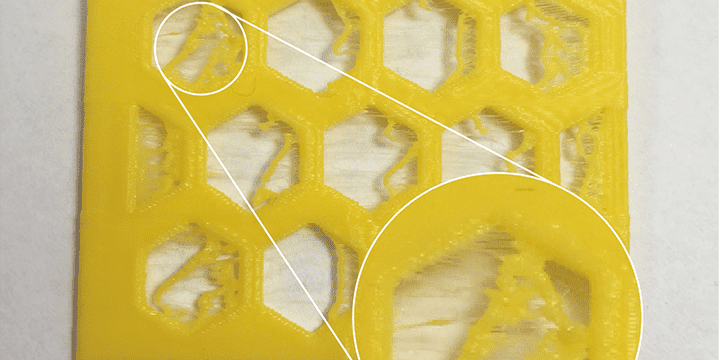3D print quality troubleshooting guide
Improve the quality of your 3D-printed parts. A guide on how to fix the most common problems.
How to fix stringing on 3D printed parts - oozing issue
The 3D printed object will have strings on it, similar to a spider net. This happens mostly when the 3D printer head has to move without printing but some material still leaves the nozzle, the material is “leaking”, the printer is oozing.
Why does stringing happen and what to do
Stringing (oozing) caused by retraction issues
Try to adjust the retraction, and reprint. If retraction is enabled, when the extruder has finished printing one part of the model, the filament will be pulled back into the nozzle to avoid stringing. When it is time to continue printing again, the filament will be pushed back into the nozzle so the material starts to extrude again. Enable retraction in REALvision Pro in the Printing settings/Expert level/Material Properties tab. See further retraction settings below.
Stringing caused by too high temperature
Lower the temperature and reprint. Adjust temperature settings in REALvision Pro in the Printing settings/Expert level/Material Properties tab. See further temperature settings below.
Printing settings in REALvision Pro
You can find the Printing Settings in REALvision Pro on the left panel as shown on the image on the left. The settings are available on three levels based on the users` experience with 3D printing: Basic, Advanced and Expert.
You can learn more in our Academy.
Retraction settings
The retraction – also called as suck-back – distance defines how much of material is moved back during retraction. This is the most important retraction setting. In most cases, the more material is sucked back from the nozzle the lower the chance of oozing is.
Direct-drive extruders mostly work well with a retraction distance of 0.5-2.0mm. Bowden extruders need a higher distance, around 15mm, due to the long distance between the extruder drive gear and the nozzle.
In case of stringing problems, try to increase the retraction distance by 1mm and test the result. In REALvision Pro it is possible to adjust the speed separately for the push-out and for the suck-back. The reason for this is because in general it requires more force form the stepper motor on the print head to push-out then to suck-back. Try to increase the suck-back speed by 10 mm/s. There is another feature in REAlvision Pro, where you can set the max suck-back during the movement. This is for high-viscosity, gooey materials. It means that you can initiate the suck back just a bit before the path finishes so you can have a very clean cut in the end. Try to increase this by 0.25 seconds.
Temperature settings
The printing temperature also has a significant effect on print quality. Too high printing temperature can also cause stringing.
If the temperature is too high, the plastic can leak out of the nozzle much more easily. The plastic will be more solid at a lower temperature.
In case of oozing problems, try to decrease the printing temperature by 5-10 degrees.
But keep in mind that the printing temperature is one of the most fundamental settings, which means that changing it has an impact on all the other settings, so you need to fine tune them again.
Speed settings
The repositioning speed defines the time the extruder moves between two printing paths. If the speed is higher stringing is less likely to happen as the movement is faster between two points, leaving less time to “spill” material in between.
Adjust printing speed settings in REALvision Pro in the Printing settings/Expert level/Motion tab/Repositioning. Increase this value by 20 mm/sec first, and see how it impacts your result.
A software program to fit your needs
If you want to get quality prints without doing 3D modeling, consider adding REALvision Pro to your 3D printer kit. We promise you easy-to-use 3D slicing software in the high-end printing industry. Suppose you are:
- A picky hobbyist with a cheap desktop 3D printer.
- Running a 3D printing service with flawless 3D prints.
- 3D printing metal parts for aerospace.
- 3D printing customizable prosthetics, implants, or casts in ABS plastic (Acrylonitrile Butadiene Styrene).
- Rapid prototyping 3D models from design software.
- Need help with calibration or material profiles.
- Finding the best 3D printer for your application.
- Exploring manufacturing processes and technology to obtain zero-waste.
In that case, we have a software plan fitting your needs.
